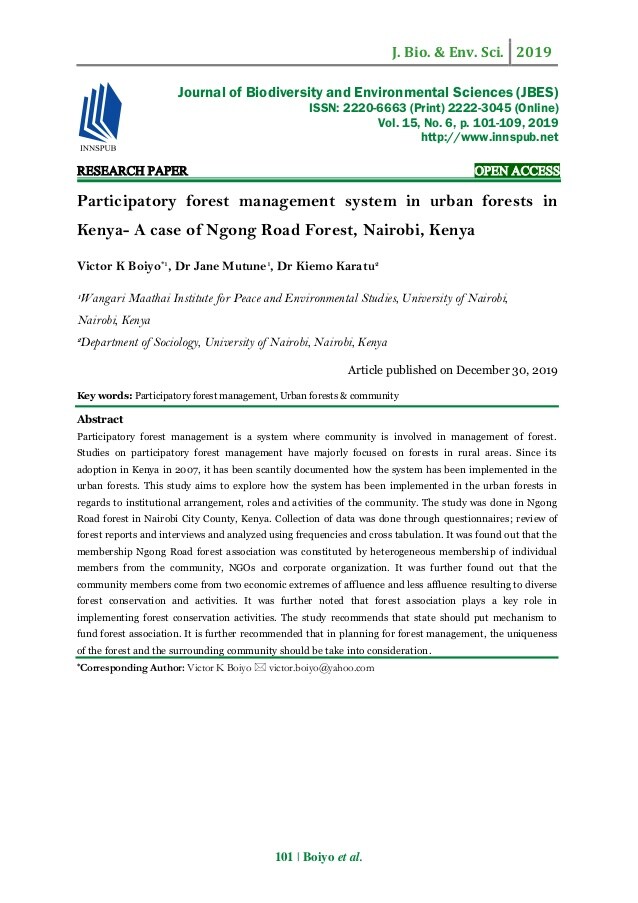JBES – An Environmental Sciences Journal published a case study about Participatory
forest management, entitle “Participatory
forest management system in urban forests in Kenya- A case of Ngong Road
Forest, Nairobi, Kenya” Victor K Boiyo, Dr Jane Mutune, and Dr Kiemo Karatu from Wangari
Maathai Institute for Peace and Environmental Studies, University of Nairobi,
and Department of Sociology, University
of Nairobi, Nairobi, Kenya, are the authors of the case study.
Abstract
Participatory forest management is a system where
community is involved in management of forest. Studies on participatory forest
management have majorly focused on forests in rural areas. Since its adoption in
Kenya in 2007, it has been scantily documented how the system has been
implemented in the urban forests. This study aims to explore how the system has
been implemented in the urban forests in regards to institutional arrangement,
roles and activities of the community. The study was done in Ngong Road forest
in Nairobi City County, Kenya. Collection of data was done through
questionnaires; review of forest reports and interviews and analyzed using
frequencies and cross tabulation. It was found out that the membership Ngong
Road forest association was constituted by heterogeneous membership of individual members from the community, NGOs and corporate organization. It was
further found out that the community members come from two economic extremes of
affluence and less affluence resulting to diverse forest conservation and
activities. It was further noted that forest association plays a key role in implementing forest conservation activities. The study recommends that state
should put mechanism to fund forest association. It is further recommended that in
planning for forest management, the uniqueness of the forest and the surrounding
community should be take into consideration.
JBES welcome all respective authors to submit their research paper / manuscripts, thesis paper in the field of Environmental Sciences, Biology, Biodiversity, Species diversity, Ecology, Taxonomy and many more via online submission panel
Introduction
This involvement of local community in forest management is aimed at fostering sustainable forest management (Polansky, 2003).
Although its’ effective and meaningful adoption was first made in Asia Pacific particularly Philippines, China and Nepal, different countries have
adopted and operationalized it indifferent ways (Mutimukuru-Maravanyika,
2010;Tesfaye et al., 2017). In this system of forest governance there is
collaboration between government forest agencies, forest adjacent community and other stakeholders (Petheram et al., 2004). Adoption of community involvement in forest governance in the Sub-Saharan African was premise don the argument that
community involvement in forest management did not only have positive impact on
forest resource but was also critical in alleviating poverty (Arnold, 2001). In
Ethiopia for instance,introduction of PFM was founded on three complementary beliefs
held by forest authorities anddonors. These beliefs were failure of centralized forest management system, effectivity of communityparticipation and the role of
forest as source oflivelihood to the community (Temesgen et al., 2012).These
are among the reasons that lead to adoption ofCommunity forestry in most
African countriesincluding but not limited to Tanzania, Burkina Fasoand
Kenya.Legal framework that led to community involvement inforest management in
Kenya came with the enactmentof Forest Act 2005 which has since then been
revised toForest Conservation and Management Act, 2016. TheAct provides for
Participatory forest management (PFM)which is modeled on provision of
incentives to localcommunities in terms of forest use rights who in returntake
collective responsibilities in forest management.Operationalization of
participatory forest managementrequires that the forest adjacent community
forms forestassociation which enters into agreement with Kenyaforest service
for the purposes of forest management.The forest associations enters and
agreement with theKenya forest service and signs a management agreementthat
stipulates which user rights they are given as theyengage in forest
conservation and management(Government of Kenya, 2016).Studies on community involvement
in forestmanagement in Kenya and other developing countrieshave provide useful
insights on this forestmanagement system (Mutune et al., 2016, Couli-Lingani,
2016, Chomba et al., 2015 and Ongugo et al.,2008). It is however observed that
these studies havehugely focused on forests in rural areas and
rurallivelihoods. Consequently, it has been scantilydocumented how the system
has been implementedin urban forests and how urban social, economic
andgeolocation factors have shaped participatory forestmanagement system.Urban
areas are characterized by socio-economic andsocio-demographic features that
are different fromwhat is in rural areas. These factors are of
potentialinfluence to how community is involved communitybased natural resource
management. As a results,findings on the institutional establishment,
practicesand outcomes of participatory forest management inrural areas may not
be the same as the context in urbanareas. With the rapid urbanization in
developingnations, there is need to establish the influence ofurban dynamics
with the aim of ensuring that theresource management system is successful. This
studywas aimed at examining how participatory forestmanagement system has been
implemented in urbanforest in Kenya with a view of establishing the influenceof
urban set up on the system of forest governance.
Reference
Arnold JM. 2001. Twenty Five Years of Community Forestry. FAO,
Rome.
Bidii HK, Ngugi PK. 2014. Challenges Impeding the Effective Implementation
of Community-Based Natural Resource Management Projects in Kenya: A Case Study
of Mji wa Huruma Village in Nairobi, Kenya. International Journal of
Social Sciences Management and Entrepreneurship 40(1(2), 141-173,
August 2014)
Chomba S, Treue T, Sinclair F. 2015. Forest Policy and Economics The
political Economy of Forest Entitlements : Can Community Based Forest
Management Reduce Vulnerability at the Forest Margin ? Forest Policy and
Economics 58, 37-46.
https://doi.org/10.1016/j.forpol.2014.11.011
Coulibaly-Lingani P. 2016. Appraisal of the Participatory Forest
Management Program in Southern Burkina Faso. Doctoral Thesis, Swedish
University of Agricultural Sciences.
Fiorino DJ. 1990. Citizen Participation and Environmental Risk: A
Survey of Institutional Mechanisms. Science, Technology & Human Values 15(2),
226-43.
Government of Kenya. 2016. Forest Conservation and Management Act, 2016.
Kenya Gazette Supplement 155(34), 677-736.
Merlet M, Fraticelli M. 2016. Protecting Forests, Improving Livelihoods –
Comparing Community Forestry in Cameroon and Guatemala European Union ISBN:
978-1-906607-62-3.
Ministry of Environment and Forestry. 2018. Taskforce Report on Forest Resources Management
and Logging Activities in Kenya, Government of Kenya.
Moss RW. 1988. Nairobi A to Z. A Complete Guide. Oxford
University Press.
Musyoki JK, Mugwe J, Mutundu K,
Muchiri M. 2016. Factors
influencing level of participation of community forest associations in
management forests in Kenya. Journal of Sustainable Forestry 35(3),
205-216, DOI: 10.1080/10549811.2016.1142454.
Mutimukuru-Maravanyika T. Ed 2010. Can we learn our way to sustainable
management? Adaptive collaborative management in Mafungausti State forest,
Zimbabwe CERES Research School for Resource Studies for Development, Wageningen
University, Wageningen, the Netherlands.
Mutune JM, Lund JF. 2016. Unpacking Impacts of Particpatory Forestry
Policies: Evidence from Kenya. Forest Policy Economics 69,
45-52.
Ongugo PO, Mogoi JN, Obonyo, E, Oeba,
VO. 2008. Examining the roles of
community forest associations in the decentralization process of Kenyan
forests. Paper Presented to the IASC Conference 11-19th July 2008, England.
Petheram RJ, Stephen P, Gilmour D. 2004. Collaborative forest management: a review.
Australian Forestry 67, 137-146.
Phiri M. 2009. Evaluation of the Performance of Joint Forest
Management (JFM) Programme : Case of Dambwa Forest Reserve in Livingstone
District, Zambia.
Polansky C. 2003. Participatory forest management in Africa:
lessons not learned. International Journal of Sustainable Development &
World Ecology 10(2), 109 – 118.
Poteete AR, Ostrom E. 2004. Heterogeneity, group size and collective
action: the role of institutions in forest management. Development and Change 35(3),
435-461.
Temesgen Z, Lemenih M. 2012. Gaps Assessment and Analysis of Participatory
Forest Management Activities in Ethiopia, MoA. Addis Ababa, Ethiopia.
Tesfaye Y, Roos A, Campbell BJ,
Bohlin F. 2017. Factors
Associated with the Performance of User Groups in a Participatory Forest
Management around Dodola Forest in the Bale Mountains , Southern Ethiopia. The
Journal of Development Studies ISSN:0022-0388.
![Participatory forest management system Participatory forest management system in urban forests in Kenya- A case of Ngong Road Forest, Nairobi, Kenya By: Victor K Boiyo, Dr Jane Mutune, Dr Kiemo Karatu Key Words: Participatory forest management, Urban forests & community J. Bio. Env. Sci. 15(6), 101-109, December 2019. Certification: jbes 2019 0238 [Generate Certificate] Abstract Participatory forest management is a system where community is involved in management of forest. Studies on participatory forest management have majorly focused on forests in rural areas. Since its adoption in Kenya in 2007, it has been scantily documented how the system has been implemented in the urban forests. This study aims to explore how the system has been implemented in the urban forests in regards to institutional arrangement, roles and activities of the community. The study was done in Ngong Road forest in Nairobi City County, Kenya. Collection of data was done through questionnaires; review of forest reports and interviews and analyzed using frequencies and cross tabulation. It was found out that the membership Ngong Road forest association was constituted by heterogeneous membership of individual members from the community, NGOs and corporate organization. It was further found out that the community members come from two economic extremes of affluence and less affluence resulting to diverse forest conservation and activities. It was further noted that forest association plays a key role in implementing forest conservation activities. The study recommends that state should put mechanism to fund forest association. It is further recommended that in planning for forest management, the uniqueness of the forest and the surrounding community should be take into consideration.](https://blogger.googleusercontent.com/img/b/R29vZ2xl/AVvXsEjckOtaiTSt_ovJaMSax2ScSvqHHuPYh4gplpwXbgYFmwckN4B9uUtQH5augt8BSkGdwzXBWWEtJcO7xKphXuLeJqYmSAAOwjBmUW3d445oZUl8k6y-UQfTQR7FcuMtKcU8j5o510g8i6w6/w640-h532/PFSM+by+Jane+Karanja.jpg)















0 comments:
Post a Comment